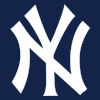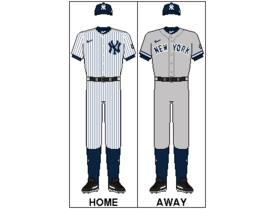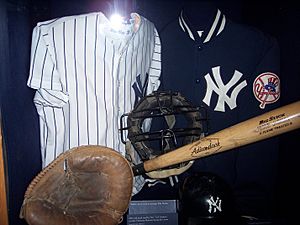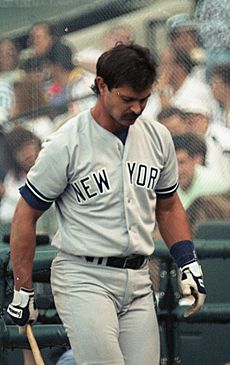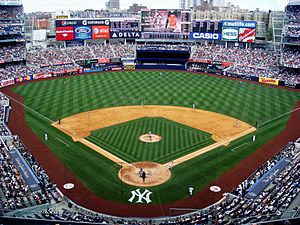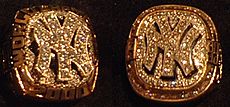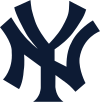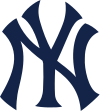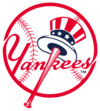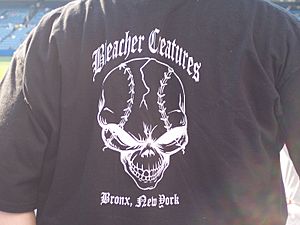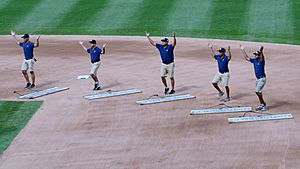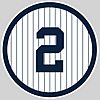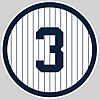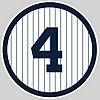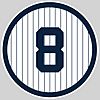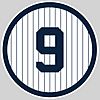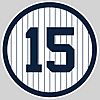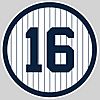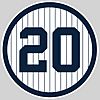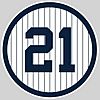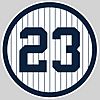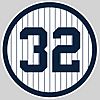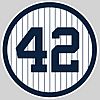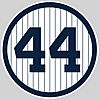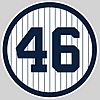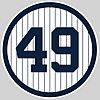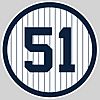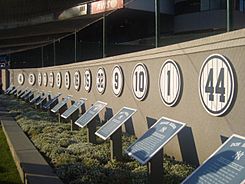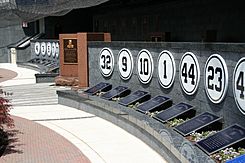New York Yankees facts for kids
Quick facts for kids New York Yankees |
|||||
|---|---|---|---|---|---|
|
|||||
|
|||||
| Major league affiliations | |||||
|
|||||
| Current uniform | |||||
| Retired numbers | |||||
| Colors | |||||
|
|||||
| Name | |||||
|
|||||
| Other nicknames | |||||
|
|||||
| Ballpark | |||||
|
|||||
| Major league titles | |||||
| World Series titles (27) | |||||
| AL Pennants (41) |
|
||||
| AL East Division titles (21) |
|
||||
| Wild card berths (9) |
|
||||
| Front office | |||||
| Principal owner(s) | Yankee Global Enterprises (Hal Steinbrenner, chairman) |
||||
| President | Randy Levine | ||||
| General manager | Brian Cashman | ||||
| Manager | Aaron Boone | ||||
The New York Yankees are a famous professional baseball team located in the Bronx, a part of New York City. They play in Major League Baseball (MLB) as part of the American League (AL) East Division. The Yankees are one of two MLB teams in New York City, the other being the New York Mets.
The team started in 1903 when Frank Farrell and Bill Devery bought the rights to the old Baltimore Orioles team. They created a new team called the New York Highlanders. In 1913, the Highlanders officially changed their name to the Yankees.
Today, the team is owned by Yankee Global Enterprises, which is controlled by the family of the late George Steinbrenner. Brian Cashman is the team's general manager, and Aaron Boone is the field manager. Aaron Judge is the team captain. The Yankees played their home games at the original Yankee Stadium from 1923 to 1973 and again from 1976 to 2008. In 1974 and 1975, they shared Shea Stadium with the Mets. In 2009, they moved into a new stadium right next to the old one. The Yankees always have many fans attending their games.
The Yankees are one of the most successful sports teams in the United States. They have won 21 American League East Division titles, 41 American League pennants, and 27 World Series championships. These are all MLB records. They have won more titles than any other team in major North American sports. Many famous players and managers from the Yankees have been inducted into the National Baseball Hall of Fame. These include legends like Babe Ruth, Lou Gehrig, Joe DiMaggio, Mickey Mantle, Yogi Berra, Whitey Ford, Reggie Jackson, Mariano Rivera, and Derek Jeter.
In 2024, Forbes magazine estimated the Yankees were worth about $7.55 billion. This made them the fourth most valuable sports team in the world. The team has a huge fanbase, but also many rivals. Their rivalry with the Boston Red Sox is one of the most famous in sports. The Yankees' logo is recognized all over the world.
From 1903 through the 2024 season, the Yankees have a winning record of 10,778 wins, 8,148 losses, and 88 ties. This is a winning percentage of .569.
Contents
- Team History
- Early Years in Baltimore and New York (1901–1912)
- New Owners and a New Name (1913–1922)
- The Ruth and Gehrig Era (1923–1935)
- The DiMaggio Years (1936–1951)
- Stengel's Dynasty (1951–1959)
- Mantle and Maris (1960–1964)
- Decline and New Ownership (1965–1972)
- The Steinbrenner Era and "Bronx Zoo" (1973–1981)
- The Mattingly Years (1982–1995)
- The Core Four Era (1996–2007)
- New Stadium and Recent Years (2008–Present)
- Team Achievements
- World Series Championships
- Team Nicknames
- Logos and Uniforms
- Fan Support
- Team Ownership
- Team Songs
- Radio and Television
- Team Personnel
- Team Rivalries
- Minor League Teams
- See also
Team History
Early Years in Baltimore and New York (1901–1912)
In 1900, Ban Johnson, who led the Western League, changed its name to the American League (AL). He wanted it to be a major league, like the National League (NL). The NL disagreed, so Johnson declared the AL a major league in 1901 anyway.
Plans for an AL team in New York City were blocked by the NL's New York Giants. So, a team was placed in Baltimore, Maryland, in 1901 and called the Orioles. The Orioles' manager, John McGraw, who was also a part-owner, left to manage the Giants in 1902. He took many players with him. The Orioles team then fell apart.
In 1903, the two leagues decided to work together. Johnson asked for an AL team in New York. Most major league owners agreed. The team was given to Frank J. Farrell and William S. Devery.
The new team's ballpark, Hilltop Park, was built in Upper Manhattan. The team was named the New York Highlanders. This name might have come from their high location or from team president Joseph Gordon's Scottish heritage. People often called them the New York Americans. Sportswriter Jim Price started calling them the "Yankees" or "Yanks" in 1904. This was because it was easier to fit in newspaper headlines.
The Highlanders finished second in the AL in 1904, 1906, and 1910. In 1904, they lost the final game to the Boston Americans (who later became the Red Sox). That year, Highlander pitcher Jack Chesbro set a record with 41 wins in one season.
New Owners and a New Name (1913–1922)
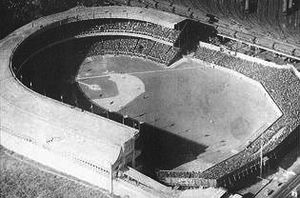
The Polo Grounds was the home of the New York Giants of the National League. The Giants and Highlanders were rivals. After their lease at Hilltop Park ended, the Highlanders shared the Polo Grounds with the Giants from 1913 to 1922. During this time, the name "Highlanders" was used less often. In 1913, the team officially became known as the New York Yankees.
In the mid-1910s, the Yankees were not doing very well. In 1915, Farrell and Devery sold the team to Colonel Jacob Ruppert and Captain Tillinghast L'Hommedieu Huston for $350,000.
The Ruth and Gehrig Era (1923–1935)

Around 1920, the Yankees started making trades with the Red Sox and Chicago White Sox. This helped the Yankees get many talented players. The most important player they got from the Red Sox was Babe Ruth, a pitcher who became an amazing outfielder. This trade was so impactful that it was later called the "Curse of the Bambino" because the Red Sox did not win a World Series for 86 years after it.
Ruth's many home runs made the Yankees very popular. In 1921, the year after they got Ruth, the Yankees played in their first World Series. They lost to the Giants. After the 1922 season, the Giants told the Yankees to leave the Polo Grounds. Giants manager John McGraw was unhappy that the Yankees were drawing so many fans. The Yankees then started building a new ballpark in the Bronx, right across the Harlem River. In 1922, the Yankees lost to the Giants again in the World Series.
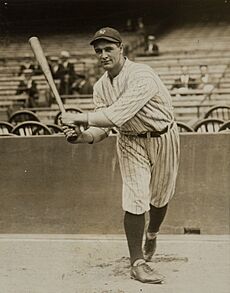
In 1923, the Yankees moved into their new home, Yankee Stadium. It cost $2.5 million to build. On Opening Day, 99,200 fans showed up, and many more were turned away. Ruth hit a home run in the first game at the new stadium. The stadium was nicknamed "The House That Ruth Built" because Ruth's popularity helped pay for it. At the end of the season, the Yankees beat the Giants in the World Series to win their first championship.
In the 1927 season, the Yankees had a lineup known as "Murderers' Row". Many people think this team was the best in baseball history. They won 110 games and swept the Pittsburgh Pirates in the World Series. Ruth hit 60 home runs that year, a record that stood for many years. First baseman Lou Gehrig also had a great season, hitting .373 with 47 home runs and 175 runs batted in (RBI). The Yankees won the World Series again in 1928.
In 1931, Joe McCarthy became the manager. The Yankees swept the Chicago Cubs in the 1932 World Series. This series is famous for Babe Ruth's "Called Shot" in Game 3, where he pointed to center field before hitting a home run. In 1935, Ruth left the Yankees and retired from baseball.
The DiMaggio Years (1936–1951)
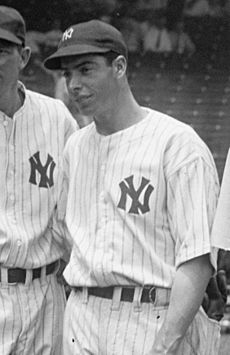
After Ruth left, Lou Gehrig became the main star. But soon, a new star, Joe DiMaggio, joined the team. The Yankees won four straight World Series titles from 1936 to 1939. In 1939, Gehrig had to stop playing baseball because of a serious illness, which became known as "Lou Gehrig's Disease." On July 4, 1939, the Yankees retired his number 4, the first number ever retired in baseball. Gehrig gave a famous speech, saying he was "the luckiest man on the face of the earth." He passed away two years later.
In 1941, DiMaggio set an amazing MLB record by getting hits in 56 games in a row. This record is still considered unbreakable. Two months after the Yankees beat the Brooklyn Dodgers in the 1941 World Series, many players, including DiMaggio, had to join the military because of World War II. Even with many players gone, the Yankees still won the 1943 World Series against the St. Louis Cardinals.
In 1945, Del Webb, Dan Topping, and Larry MacPhail bought the team. After a few tough seasons, Bucky Harris became manager in 1947 and led the Yankees to another World Series win against the Dodgers. In 1949, Casey Stengel became manager. He had a reputation for being funny and managing bad teams, but he brought great success to the Yankees. DiMaggio's career ended after the 1951 season due to injuries. That year, a new star, Mickey Mantle, joined the team.
Stengel's Dynasty (1951–1959)

Under Casey Stengel, the Yankees won the World Series five times in a row from 1949 to 1953. This is still an MLB record. Key players during this time included Mickey Mantle, pitcher Whitey Ford, and catcher Yogi Berra. Stengel's teams won ten AL pennants and seven World Series titles in his 12 seasons as manager.
In 1954, the Yankees won 103 games, but the Cleveland Indians won the pennant with 111 wins. In 1955, the Dodgers finally beat the Yankees in the World Series after losing to them five times before. The Yankees got their revenge the next year. In Game 5 of the 1956 World Series, pitcher Don Larsen threw the only perfect game in World Series history.
The Yankees lost the 1957 World Series to the Milwaukee Braves. After this, the New York Giants and Brooklyn Dodgers moved to California, leaving the Yankees as New York's only baseball team. In the 1958 World Series, the Yankees beat the Braves. In the 1950s, the Yankees won six World Series and eight American League pennants. With players like Mantle, Ford, Berra, Elston Howard (the Yankees' first African-American player), and Roger Maris, the Yankees were ready for more success in the 1960s.
Mantle and Maris (1960–1964)

The owner of the Kansas City Athletics, Arnold Johnson, had a special relationship with the Yankees. He often traded young players to the Yankees for cash and older players. These trades usually helped the Yankees a lot. In 1960, Charles O. Finley bought the Athletics and stopped these trades. But by then, the Yankees had already gained many future stars, including Roger Maris. In 1960, Maris had a great season and won the American League MVP award.
The year 1961 was very memorable for the Yankees. Mantle and Maris hit home runs at an incredible pace. They were known as the "M&M Boys". Mantle got a hip infection and had to leave the lineup. But Maris kept going, and on October 1, he hit his 61st home run. This broke Babe Ruth's single-season record of 60. The Yankees won the pennant and then defeated the Cincinnati Reds in the 1961 World Series.
In 1962, the New York Mets joined the National League, bringing New York back to having more than one baseball team. The Yankees won the 1962 World Series, their tenth in 16 years, by beating the San Francisco Giants. This was the Yankees' last championship until 1977.
The Yankees easily won the pennant in 1963, but they were swept by the Los Angeles Dodgers in the 1963 World Series. After the season, Yogi Berra became the manager. The aging Yankees made it to a fifth straight World Series in 1964, but lost to the St. Louis Cardinals. This was their last World Series appearance until 1976.
Decline and New Ownership (1965–1972)
After the 1964 season, the broadcasting company CBS bought 80% of the Yankees for $11.2 million. With this new ownership, the team started to struggle. In 1965, the Yankees had their first losing record in 40 years. In 1966, they finished in last place in the AL for the first time since 1912. They continued to have losing seasons.
The Yankees were not able to find new young stars to replace their older players. This was made worse by the new amateur draft that started in 1965. This meant the Yankees could no longer sign any player they wanted. During this period, Thurman Munson was one of the few successful players drafted by the Yankees.
The Steinbrenner Era and "Bronx Zoo" (1973–1981)
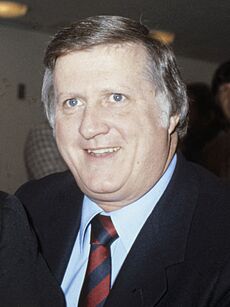
On January 3, 1973, CBS sold the team to a group of investors led by George Steinbrenner. Steinbrenner soon bought out most of his partners and became the main owner. One of his first goals was to renovate Yankee Stadium, which had become old and run down. The city bought the stadium and began a two-year renovation. During this time, the Yankees played at Shea Stadium, sharing it with the Mets.
In 1973, Steinbrenner started a rule that players had to be clean-shaven with neat hair. This rule came from his time in the United States Air Force. This policy was still in place until 2025, when it was changed to allow well-groomed beards.
After the 1974 season, Steinbrenner signed star pitcher Catfish Hunter, which was a big move in the new era of free agency. In 1975, the team hired former player Billy Martin as manager. Under Martin, the Yankees reached the 1976 World Series, but lost to the Cincinnati Reds.
In 1977, Steinbrenner added star outfielder Reggie Jackson. Jackson often argued with his teammates and manager Billy Martin. Martin and Steinbrenner also had many disagreements. Martin was hired and fired by Steinbrenner five times over 13 years. This constant conflict, along with the rowdy fans and tough conditions in the Bronx, led to the team and stadium being called the "Bronx Zoo". Despite the problems, Jackson hit four home runs in the 1977 World Series and earned the nickname "Mr. October."
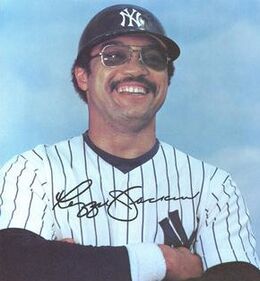
In 1978, the Red Sox were far ahead of the Yankees in July. Billy Martin was forced to resign and was replaced by Bob Lemon. The Yankees started winning many games. In September, the Yankees swept the Red Sox in a series known as the "Boston Massacre." On the last day of the season, the two teams were tied. The Yankees won a tie-breaker game, thanks to a famous home run by Bucky Dent.
After beating the Kansas City Royals in the playoffs, the Yankees faced the Los Angeles Dodgers in the World Series. They lost the first two games but came back to win the next four, winning their 22nd championship.
On August 2, 1979, catcher Thurman Munson, the team captain, passed away in a plane crash. His number 15 was immediately retired. His locker has remained empty in the Yankees clubhouse as a memorial.
In 1980, the Yankees won 103 games and the AL East, but were swept by the Royals in the playoffs. After the season, the Yankees signed Dave Winfield to a big contract. In 1981, a strike shortened the season. The Yankees made it to the World Series but lost to the Los Angeles Dodgers.
The Mattingly Years (1982–1995)
After losing the 1981 World Series, the Yankees had their longest time without reaching the playoffs since 1921. The Yankees of the 1980s were led by All-Star first baseman Don Mattingly. Even though they won more games than most other teams, they did not win a World Series during this decade. They had a strong offense but lacked enough good starting pitchers.
Many talented young pitchers like Al Leiter, Doug Drabek, and José Rijo were on the Yankees roster but were traded away before they reached their full potential. The team came close to winning the AL East in 1985 and 1986 but then fell in the standings. By the end of the 1980s, the Yankees' offense also declined. From 1989 to 1992, the team had losing records. In 1990, the Yankees had the worst record in the American League.
During the 1990 season, Yankee fans started chanting "1918!" to tease the Red Sox about the last time they won a World Series. These fans became known as the Bleacher Creatures.
The team's struggles began to change when George Steinbrenner was suspended from daily team operations for two years. This allowed general manager Gene Michael and manager Buck Showalter to focus on developing young talent from their farm system. This led to key players like Bernie Williams, Derek Jeter, Jorge Posada, Andy Pettitte, and Mariano Rivera. In 1994, the Yankees had the best record in the AL, but the season was cut short by a players' strike.
In 1995, the team made the playoffs as a wild card. In a memorable series against the Seattle Mariners, the Yankees won the first two games but lost the next three. Mattingly played well in his only postseason series, but his back problems led him to retire after the 1997 season.
The Core Four Era (1996–2007)
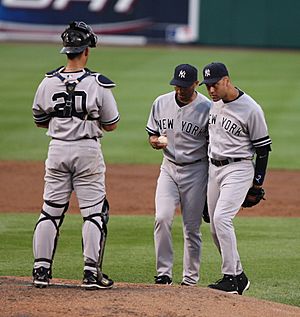
Joe Torre became the new Yankees manager in November 1995. His calm style worked well, and he managed the team for a long time. The 1996 season saw the rise of three key players: rookie shortstop Derek Jeter, pitcher Andy Pettitte, and pitcher Mariano Rivera. These young players helped the Yankees win their first AL East title in 15 years. They defeated the Texas Rangers and the Baltimore Orioles in the playoffs. In the World Series, they came back from being down 0–2 to defeat the Atlanta Braves, ending an 18-year championship drought. Jeter was named Rookie of the Year.
In 1997, the Yankees lost in the playoffs. Brian Cashman became the new general manager. The 1998 Yankees are considered one of the greatest teams ever. They won 114 games, an AL record. David Wells pitched a perfect game that season. The Yankees then swept the San Diego Padres in the World Series. Their 125 combined regular and postseason wins is an MLB record. In 1999, David Cone pitched another perfect game. The 1999 Yankees defeated the Red Sox in the playoffs and swept the Braves in the 1999 World Series.
In 2000, the Yankees faced the Mets in the first New York City Subway World Series in 44 years. The Yankees won in 5 games. They became the last MLB team to win three World Series in a row.
After the September 11, 2001, terrorist attacks, the Yankees won their playoff series against the Oakland Athletics and Seattle Mariners. They won the AL pennant for the fourth straight year. In the World Series against the Arizona Diamondbacks, the Yankees lost in Game 7. Derek Jeter hit a walk-off home run in Game 4, earning him the nickname "Mr. November."
In 2002, the Yankees had the best record in the AL, but lost in the playoffs to the Anaheim Angels. In 2003, they again had the best record. They defeated the Boston Red Sox in a dramatic seven-game series, with Aaron Boone hitting a walk-off home run in Game 7. However, they lost the World Series to the Florida Marlins.
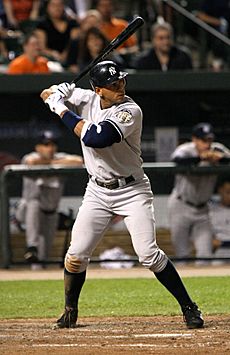
In 2004, the Yankees traded for star shortstop Alex Rodriguez, who moved to third base. In the ALCS, the Yankees faced the Red Sox again. The Yankees took a 3–0 lead in the series but lost the next four games. This was the first time in baseball history a team lost a best-of-seven series after being up 3–0. The Red Sox went on to win their first World Series since 1918.
In 2005, Alex Rodriguez won the American League MVP award. In 2006, the Yankees swept the Red Sox in a 5-game series at Fenway Park. The Yankees' streak of nine straight AL East titles ended in 2007, but they still made the playoffs. They lost in the first round to the Cleveland Indians. After this, Joe Torre left and became manager of the Los Angeles Dodgers.
New Stadium and Recent Years (2008–Present)
After Joe Torre left, the Yankees hired former catcher Joe Girardi as manager. The 2008 season was the last played at the original Yankee Stadium. The 2008 Major League Baseball All-Star Game was held there. The Yankees missed the playoffs for the first time in 14 seasons.
In 2009, the Yankees opened the new Yankee Stadium. They signed star free agents like CC Sabathia, Mark Teixeira, and A. J. Burnett. The Yankees swept the Minnesota Twins in the playoffs and defeated the Los Angeles Angels. They then beat the Philadelphia Phillies in the World Series 4–2, winning their 27th title.
In 2010, longtime public address announcer Bob Sheppard and owner George Steinbrenner passed away. In 2011, the Yankees made history by hitting three grand slams in one game. In 2012, the Yankees had the AL's best record. They beat the Orioles in the playoffs but lost to the Tigers.
In 2013, the Yankees made their second triple play ever. They missed the playoffs that year. On September 25, 2014, Derek Jeter played his final home game and hit a walk-off single.
Before the 2016 season, the Yankees acquired closer Aroldis Chapman. The team struggled in 2016 and finished in 4th place. They traded away some players to focus on the future.
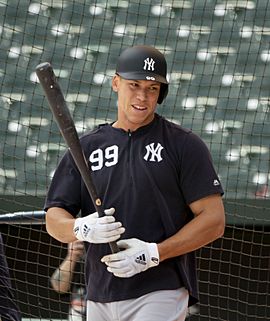
In August 2016, Tyler Austin and Aaron Judge made their debuts, hitting back-to-back home runs. Catcher Gary Sánchez also had a great rookie season. These young players were nicknamed the "Baby Bombers."
In 2017, Aaron Judge led the American League with 52 home runs, breaking the rookie record. He also won the Home Run Derby and was named Rookie of the Year. In the 2017–18 off-season, the Yankees hired Aaron Boone as their new manager and traded for Giancarlo Stanton, who had hit 59 home runs in 2017.
In 2019, the Yankees played the Red Sox in the first ever MLB London Series in Europe. The Yankees swept the series. They beat the Twins in the playoffs but lost to the Houston Astros in the ALCS. This was the first decade since the 1910s that the Yankees did not play in a World Series. In December 2019, the Yankees signed pitcher Gerrit Cole.
On May 19, 2021, Corey Kluber threw a no-hitter for the Yankees, their 12th all-time. The Yankees also recorded three triple plays that season. In 2022, the Yankees had their 30th straight winning season. On October 4, Aaron Judge hit his 62nd home run, breaking Roger Maris's American League single-season record. Judge also won the AL MVP award.
On December 21, 2022, Aaron Judge was named the 16th captain in Yankees history. On June 28, 2023, Domingo Germán threw the 24th perfect game in MLB history, and the fourth for the Yankees. After the 2023 season, shortstop Anthony Volpe won the Gold Glove Award, and Gerrit Cole won the AL Cy Young Award.
On December 6, 2023, the Yankees traded for superstar Juan Soto. This helped the Yankees win their 21st AL East title in 2024 and secure the top spot in the American League. Aaron Judge had another historic season, hitting 50 or more home runs for the third time. In the ALCS, the Yankees defeated the Cleveland Guardians. Giancarlo Stanton was named ALCS MVP. The Yankees won their 41st AL Pennant and faced the Los Angeles Dodgers in the 2024 World Series. This was the 12th time these two teams met in the World Series, an MLB record. The Yankees lost to the Dodgers in five games. Aaron Judge won his second AL MVP award after the season.
Team Achievements
The Yankees have won 27 World Series in 41 appearances. This is the most in Major League Baseball and in major North American professional sports. The St. Louis Cardinals are second with 11 World Series championships. The Dodgers are second in total World Series appearances with 22. The Yankees have lost 14 World Series, tied with the Dodgers for the most in MLB. The Yankees have played the Dodgers in 12 World Series, winning 8 of them.
Through 2024, the Yankees have the best all-time regular season winning percentage in MLB history, at .569. On June 25, 2019, they set a new major league record by hitting a home run in 28 straight games. This streak reached 31 games. In August 2019, the Yankees set a new record for most home runs hit in a single month by one team, with 74.
World Series Championships
The Yankees have won a record 27 World Series championships. Their most recent win was in 2009, when they defeated the Philadelphia Phillies.
| Season | Manager | Opponent | Series score | Record |
|---|---|---|---|---|
| 1923 | Miller Huggins | New York Giants | 4–2 | 98–54 |
| 1927 | Miller Huggins | Pittsburgh Pirates | 4–0 | 110–44 |
| 1928 | Miller Huggins | St. Louis Cardinals | 4–0 | 101–53 |
| 1932 | Joe McCarthy | Chicago Cubs | 4–0 | 107–47 |
| 1936 | Joe McCarthy | New York Giants | 4–2 | 102–51 |
| 1937 | Joe McCarthy | New York Giants | 4–1 | 102–52 |
| 1938 | Joe McCarthy | Chicago Cubs | 4–0 | 99–53 |
| 1939 | Joe McCarthy | Cincinnati Reds | 4–0 | 106–45 |
| 1941 | Joe McCarthy | Brooklyn Dodgers | 4–1 | 101–53 |
| 1943 | Joe McCarthy | St. Louis Cardinals | 4–1 | 98–56 |
| 1947 | Bucky Harris | Brooklyn Dodgers | 4–3 | 97–57 |
| 1949 | Casey Stengel | Brooklyn Dodgers | 4–1 | 97–57 |
| 1950 | Casey Stengel | Philadelphia Phillies | 4–0 | 98–56 |
| 1951 | Casey Stengel | New York Giants | 4–2 | 98–56 |
| 1952 | Casey Stengel | Brooklyn Dodgers | 4–3 | 95–59 |
| 1953 | Casey Stengel | Brooklyn Dodgers | 4–2 | 99–51 |
| 1956 | Casey Stengel | Brooklyn Dodgers | 4–3 | 97–57 |
| 1958 | Casey Stengel | Milwaukee Braves | 4–3 | 92–62 |
| 1961 | Ralph Houk | Cincinnati Reds | 4–1 | 109–53 |
| 1962 | Ralph Houk | San Francisco Giants | 4–3 | 96–66 |
| 1977 | Billy Martin | Los Angeles Dodgers | 4–2 | 100–62 |
| 1978 | Bob Lemon | Los Angeles Dodgers | 4–2 | 100–63 |
| 1996 | Joe Torre | Atlanta Braves | 4–2 | 92–70 |
| 1998 | Joe Torre | San Diego Padres | 4–0 | 114–48 |
| 1999 | Joe Torre | Atlanta Braves | 4–0 | 98–64 |
| 2000 | Joe Torre | New York Mets | 4–1 | 87–74 |
| 2009 | Joe Girardi | Philadelphia Phillies | 4–2 | 103–59 |
| Total World Series championships: | 27 | |||
Team Nicknames
The Yankees have many nicknames. Sportswriter Fred Lieb started calling them "the Yanks" in 1922. Their most famous nickname is "the Bronx Bombers" or "the Bombers." This refers to their home in the Bronx and their powerful hitting. The name "Bronx Bombers" was first used in 1928.
Another nickname is "the Pinstripes," because of the stripes on their home uniforms. The term "Murderers' Row" has been used for the 1920s Yankees and sometimes for the team in general. It came from a jail complex in New York. Some critics call the team "the Evil Empire," a name given by the Boston Red Sox president in 2002. Yankees fans often use this name as a badge of honor. The team even plays "The Imperial March" from Star Wars at home games.
Logos and Uniforms
The Yankees' logo and uniform have changed over time. In 1903, the uniform had a large "N" and "Y" on the chest. In 1909, the "N" and "Y" were combined into the interlocking "NY" design, which was added to caps and jerseys. This interlocking "NY" design actually existed before the Yankees, appearing on a New York City Police Department medal from 1877. Black pinstripes were added to the uniforms in 1912. The current navy blue cap with the white interlocking "NY" was adopted in 1932. The home and away uniforms have stayed mostly the same since the 1920s and 1940s. The away uniform is grey with "NEW YORK" across the chest.
Yankees merchandise, like baseball caps, is popular worldwide. Many people wear Yankees caps even in countries where baseball is not a major sport. For example, in Brazil, many people wear Yankees caps because they see it as a classic American symbol, not necessarily knowing it's a baseball team.
Fan Support
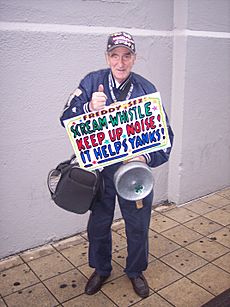
The Yankees have been one of the most popular teams in the world since the 1920s. Their fans come from all over, not just the New York area. When the Yankees play away games, many of their fans show up, and local fans are also more interested.
The Yankees consistently have the highest attendance in MLB. In 1920, over 1.2 million fans attended Yankee games. In 2005, they set an American League record with over 4 million fans attending games at their ballpark. The Yankees also led the league in "road attendance" from 2001 to 2006.
Some Yankees fans have become famous themselves. One well-known fan was Freddy Schuman, known as "Freddy Sez." For over 50 years, he attended home games with a special pan and signs to cheer on the team. He passed away in 2010. The Yankees' popularity also reaches internationally. An MLB executive said the Yankees logo is seen as a "sign of quality" even by people who don't know much about the team.
The Bleacher Creatures
The "Bleacher Creatures" are a group of loyal Yankees fans. They used to sit in Section 39 at the old Yankee Stadium and now sit in Section 203 at the new stadium. They are known for their chants and songs, especially the "roll call" at the start of every home game.
A newspaper columnist named Filip "Flip" Bondy gave them their nickname. The Bleacher Creatures have sometimes been criticized for being too loud or using harsh chants towards opposing fans and players.
The Judge's Chambers
In 2017, the Yankees created a special cheering section for fans of outfielder Aaron Judge, called "the Judge's Chambers." It's in Section 104. The 18 seats in this section are given to lucky ticket holders and their families. They get to wear black judicial robes with the team logo and Judge's number 99. Sometimes, community groups or Little League teams get these seats. The section is designed to look like a courthouse, with mahogany wood.
Team Ownership
The Yankees baseball club is owned by Yankee Global Enterprises. This company is mostly owned by the Steinbrenner family. Yankee Global Enterprises also owns a big part of the YES Network, which is the Yankees' main TV channel.
After buying the team in 1973, George Steinbrenner was very involved in how the team was run. In 2005, he stepped back from daily operations, and his son-in-law, Steve Swindal, took over. In 2007, George's son Hal Steinbrenner became the chairman of Yankee Global Enterprises. George Steinbrenner passed away in 2010, and his other son, Hank, passed away ten years later. Hal Steinbrenner is now the main managing partner.
The Yankees are consistently one of the most valuable sports teams in the world. In 2024, Forbes magazine valued the team at $7.55 billion. This made them the fourth most valuable sports team globally.
Criticism
Because the Yankees have been so successful and have so many fans, many fans of other teams dislike them. When the Yankees play away games, it's common for home fans to chant "Yankees Suck." A website called FiveThirtyEight found that the Yankees were MLB's least liked team.
Much of this dislike comes from their high payroll. Some people think the Yankees "buy" championships instead of developing players. In 2008, their payroll was around $200 million, the highest in American sports. During his time as owner, George Steinbrenner was known for publicly criticizing players and managers. He also changed managers many times.
Team Songs
The official fight song for the Yankees is "Here Come the Yankees". It was written in 1967. However, this song is not as popular with fans as other team songs. Another song strongly linked to the team is "New York, New York". This song is played in the stadium after home games. George Steinbrenner started playing it in 1980. The Frank Sinatra version is usually played after wins. Starting in 2025, the team stopped playing it after losses, choosing other Sinatra songs instead.
Many songs are played regularly at the stadium, some live on the stadium's organ. "God Bless America" has been played during the seventh-inning stretch since September 11, 2001. The team now uses a recording by Robert Merrill. During the 5th inning, the grounds crew dances to "Y.M.C.A." while working.
Radio and Television
The Yankees Entertainment and Sports (YES) Network started in 2002 and is the main TV home for the Yankees. As of 2022, Michael Kay is the play-by-play announcer. David Cone, John Flaherty, and Paul O'Neill are commentators. Bob Lorenz hosts the pre-game and post-game shows. Some games are also available on Amazon Prime. Radio broadcasts are on the Yankees Radio Network, with WFAN 660 AM as the main station. Dave Sims is the play-by-play announcer, and Suzyn Waldman provides commentary. Spanish-language broadcasts are on WADO 1280 AM.
Past Announcers
- Mel Allen was the team's lead announcer from 1948 to 1964, known as "The voice of the Yankees."
- Red Barber called Yankees games for 13 seasons (1954–1966).
- Jerry Coleman called games from 1963 to 1970. He was also a Yankees second baseman.
- Frank Messer, Phil Rizzuto, and Bill White worked together in the 1970s and 1980s. Rizzuto was the longest-serving broadcaster for the team.
- Bobby Murcer called games for over 20 years.
- John Sterling called Yankees games on radio from 1989 to 2024.
Team Personnel
Retired Numbers
The Yankees have retired 22 numbers for 24 individuals, which is the most in Major League Baseball.
|
The retired numbers are displayed in Monument Park at Yankee Stadium. They are placed in order, starting with Lou Gehrig's number 4. His number was retired on July 4, 1939, making it the first number ever retired in Major League Baseball.
Number 42 was retired throughout all of Major League Baseball in honor of Jackie Robinson on April 15, 1997. This was to celebrate him breaking the color barrier in baseball. Players who wore number 42 at that time were allowed to keep wearing it. Mariano Rivera was the last active player to wear number 42.
In 1972, number 8 was retired for two players on the same day: Bill Dickey and Yogi Berra. Berra took over Dickey's number in 1948. Numbers 37 (for Casey Stengel) and 6 (for Joe Torre) are the only numbers retired by the Yankees for someone who only managed the team. Stengel led the Yankees to ten pennants and seven World Series wins. Joe Torre managed the Yankees from 1996 to 2007, winning six pennants and four World Series. On May 14, 2017, the Yankees retired number 2 for Derek Jeter. This means 0 is the only single-digit number still available for future Yankees players.
Hall of Famers
| New York Yankees Hall of Famers | |||||||||||||||||||||||||||
|---|---|---|---|---|---|---|---|---|---|---|---|---|---|---|---|---|---|---|---|---|---|---|---|---|---|---|---|
| Affiliation according to the National Baseball Hall of Fame and Museum | |||||||||||||||||||||||||||
|
| New York Yankees Ford C. Frick Award recipients | |||||||||
|---|---|---|---|---|---|---|---|---|---|
| Affiliation according to the National Baseball Hall of Fame and Museum | |||||||||
|
Team Rivalries
The Yankees have several rivalries. Their most famous one is with the Boston Red Sox. They also have historic rivalries with the Los Angeles Dodgers and San Francisco Giants. More recently, they have a rivalry with the Houston Astros.
Boston Red Sox Rivalry
The Yankees–Red Sox rivalry is one of the oldest and most intense rivalries in sports. It started over 100 years ago, in 1903. A big part of the rivalry is the "Curse of the Bambino". This refers to when Babe Ruth was traded to the Yankees in 1920. After that trade, the Red Sox did not win a World Series for 86 years, until 2004.
This rivalry is very strong, especially in the Northeastern United States. The teams have met in the playoffs five times. Games between them are often shown on national television and get high ratings.
In 1978, the Red Sox had a 14-game lead over the Yankees, but the Yankees caught up and won a tie-breaker game. In the 2004 ALCS, the Yankees were up 3-0 in the series but lost the next four games to the Red Sox. This was the only time in MLB history a team came back from a 0–3 deficit to win a playoff series.
Subway Series
The "Subway Series" refers to games played between baseball teams in New York City. The name comes from the New York City Subway system, which connects the stadiums. Historically, it meant games between the Yankees and either the New York Giants or the Brooklyn Dodgers. When the Dodgers and Giants moved to California, the New York Mets were created in 1962.
The term "Subway Series" was mainly used for World Series games between New York teams. The Yankees have played in all Subway Series championships and have won 11 out of 14. The most recent World Series between New York teams was in 2000, when the Yankees beat the Mets. Since 1997, the term also applies to regular season games between the Yankees and Mets.
Minor League Teams
The New York Yankees have six minor league teams where young players develop their skills.
| Class | Team | League | Location | Ballpark | Affiliated |
|---|---|---|---|---|---|
| Triple-A | Scranton/Wilkes-Barre RailRiders | International League | Moosic, Pennsylvania | PNC Field | 2007 |
| Double-A | Somerset Patriots | Eastern League | Bridgewater Township, New Jersey | TD Bank Ballpark | 2021 |
| High-A | Hudson Valley Renegades | South Atlantic League | Wappingers Falls, New York | Heritage Financial Park | 2021 |
| Single-A | Tampa Tarpons | Florida State League | Tampa, Florida | George M. Steinbrenner Field | 1994 |
| Rookie | FCL Yankees | Florida Complex League | 1980 | ||
| DSL Yankees | Dominican Summer League | Boca Chica, Santo Domingo | New York Yankees Complex | 1994 |
See also
 In Spanish: New York Yankees para niños
In Spanish: New York Yankees para niños
- List of World Series champions
- List of New York Yankees managers



